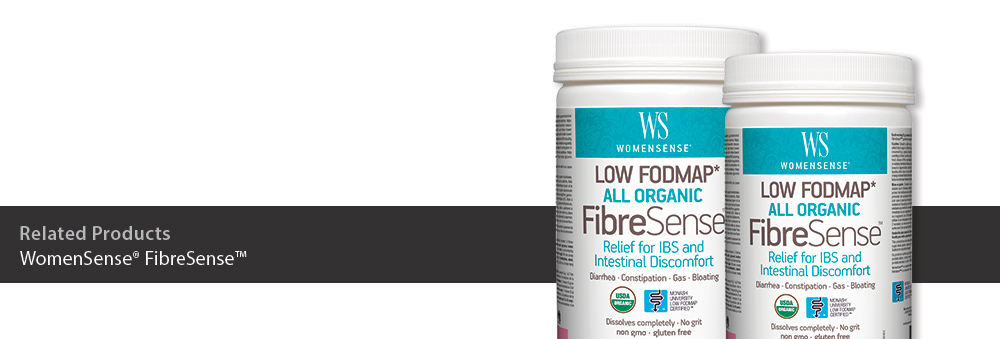

Getting fibre without FODMAPs
Fibre is an essential part of a healthy diet; however, the average adult in Canada consumes far less than the recommended 21–38 g of dietary fibre per day (1). A moderate intake of dietary fibre has been associated with maintaining overall health (1). This includes soluble fibre, which is fermented by beneficial bacteria in the gut. Soluble fibre enhances gastrointestinal health, function, and regularity, while also lowering the glycemic index (GI) of foods.
Many high-fibre foods and supplements are high in FODMAPs (fermentable oligosaccharides, disaccharides, monosaccharides, and polyols). These are small carbohydrates and sugar alcohols that some people have difficulty digesting because of their inability to absorb them from the small intestine and their rapid fermentation in the gut (2). For people with irritable bowel syndrome (IBS) and other digestive disorders, eating FODMAPs can result in abdominal discomfort, bloating, gas, and diarrhea or constipation. Because FODMAPS are found in many common foods, such as legumes, wheat, milk, apples, broccoli, cauliflower, onion, garlic, and sweeteners, it can be challenging for people with digestive disorders to get enough fibre through their diets.
Organic FibreSense is free of FODMAPs. It contains partially hydrolyzed guar gum (PHGG), a natural water-soluble, non-digestible dietary fibre made from the guar plant seed. PHGG is produced by controlled partial enzymatic hydrolysis of guar gum, but maintains the same metabolic nutritional and analytical properties. Guar gum is fermented more slowly in the intestinal tract than some other prebiotic fibres, making it easily tolerated. Evidence shows that a low-FODMAP diet is an important part of managing functional digestive disorders, such as IBS (2).
PHGG stimulates gut microflora and helps relieve symptoms of IBS, improving stool condition in either constipation or diarrhea, in both adults and children. A randomized double-blind placebo-controlled study found that supplementing adult IBS patients with 6 g of PHGG per day for 12 weeks significantly improved abdominal bloating and gas (3). Another study found that taking 5 g or 10 g doses of PHGG per day for 12 weeks can help improve gastrointestinal symptoms and quality of life for up to three months (4). A similar study on children aged 8–16 found that a 5 g dose of PHGG per day for four weeks was 38% more successful at reducing symptoms of IBS than a placebo. It also showed a tendency to support normal bowel movements (5).
Constipation affects 25% of Canadians and increasing dietary fibre intake is often the first step in managing it (1). This includes soluble fibre, which enhances gastrointestinal health, function, and regularity. A meta-analysis of 15 clinical trials found that a daily 5–7 g dose of PHGG significantly reduced incidences of constipation without causing adverse effects. Researchers also found that PHGG was equally effective at reducing constipation as laxatives (6).
PHGG also supports healthy blood sugar balance by lowering the glycemic index of food. A 12-month clinical study revealed that participants who took 6 g of PHGG with each meal significantly lowered their post-meal blood glucose levels, in addition to both fasting and post-meal insulin levels. Furthermore, 50% of glucose-intolerant participants were observed to be normal glucose tolerant after three months of supplementation (7).
References:
1. Abdullah, M., Gyles, C., Marinangeli, C., et al. (2015). Dietary fibre intakes and reduction in functional constipation rates among Canadian adults: a cost-of-illness analysis. Food Nutr Res,
2. Gibson, P.R., Shepherd, S.J. (2010). Evidence-based dietary management of functional gastrointestinal symptoms: The FODMAP approach. J Gastroenterol Hepatol, 25(2), 252-8.
3. Niv, E., Halak, A., Timney, E., et al. (2016). Randomized clinical study: Partially hydrolyzed guar gum (PHGG) versus placebo in the treatment of patients with irritable bowel syndrome. Nutr Metab, 6(13), 10.
4. Parisi, G.C., Zilli, M., Miani, M.P., et al. (2002). High-fiber diet supplementation in patients with irritable bowel syndrome (IBS): A multicenter, randomized, open trial comparison between wheat bran diet and partially hydrolyzed guar gum (PHGG). Dig Dis Sci, 47(8), 1697-704.
5. Romano, C., Comito, D., Famiani, A., et al. (2013). Partially hydrolyzed guar gum in pediatric functional abdominal pain. World J Gastroenterol, 19(2), 235-40.
6. Kapoor, M., Sugita, M., Fukuzawa, Y., Okubo T. (2017). Impact of partially hydrolyzed guar gum (PHGG) on constipation prevention: A systematic review and meta-analysis. J Func Foods, 33, 52-66.
7. Kapoor, M., Ishihara, N., Okubo, T. (2016). Soluble dietary fibre partially hydrolysed guar gum markedly impacts on postprandial hyperglycaemia, hyperlipidaemia and incretins metabolic hormones over time in healthy and glucose intolerant subjects. J Func Foods, 24, 207-20.

